ANTH 469A/SISEA 490B, Spring 2006
Ethnograpies of
Rural-Urban Encounter in China
What is your favorite Seatte intersection? How does it
characterize your relationship with the city of Seattle and your
identification with urban and/or rural space?
I would have to say that my favorite intersection in Seattle would be the street between 7th and Pine. This intersection is located near the heart of Seattle down town’s shopping centers, about a block down from Pacific Place. It is just a typical intersection you could find all over the downtown area however, to me, it feels much more lively and energetic than other parts of Seattle. By this I am referring to the live music and lots of people who walk along these streets. I enjoy the feeling of being around a lot of people, especially when it comes to walking around, shopping, eating, or going to events.

The intersection that I chose to describe is surrounded by many tall buildings; such as businesses, apartments, restaurants, and shopping centers. It is a very busy intersection with a lot of activity happening in that vicinity. In other parts of Seattle, you cannot find that much activity or that many people along the streets. I also like the fact that Seattle downtown has many nightlife activities. There are some cafes that are open until late, lots of restaurants, nightclubs or bars. It is still well-lit and has people walking about the streets and cars moving about. I thought that this part of Seattle displays Seattle’s image of how tourists or outsiders would image the city of Seattle.
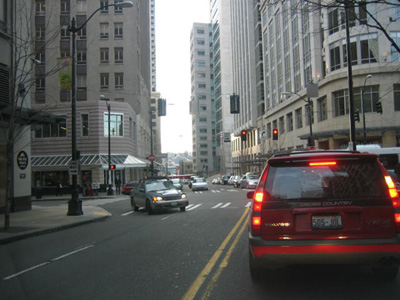
Growing up most of my life in Seattle, it is something I am rather used
to. That is probably why I would not be able to make an easy
transition from living in an urban city to moving to the rural
countryside. I’d rather prefer the urban life because I
like the fast paced life-style with lots of people and new
technologies. Also, I’d like to be able to go shopping or watch a
movie, without having to drive hours into the city to do so. I
have experienced visits to rural areas in parts of Washington, however
I cannot even imagine living in secluded areas without many people or
much activity. I think I can relate to the people who do live in
rural parts of the country. Most of the people who do live in the
country are older or retired. They enjoy the slow paced everyday
life, without too much of the chaos that you would normally find
throughout the city.
My
parents I believe wanted to live in a more rural area however, they
knew that the children want to live in the urban area because there is
more interaction with other children and more activities that they
could be involved with. I agree with my parents because I would
probably do the same if I had children. I am not saying that
raising your children in the urban area is wrong or a bad thing
however, I personally would want my children growing up with more
interaction and I feel that they can be more educated.
Overall, I felt that the intersection that I chose best reflected the
way I feel about the rural city. I felt that it also best
reflected upon my characteristics and personality. Even thought I
am not very outgoing and talkative, I enjoy atmospheres where there is
so much going on at once. I enjoy the company of people and the
sounds of people talking and singing or cars passing by. I also
take pleasure in going to the shopping malls, eating at nice
restaurants with my friends, or having a cup of coffee with my
friends. I feel that this kind of life style is what urban
residents engage in as well as enjoy.
(Jordann)

4th and Pine, is a marker in my
mind of what Seattle is because it is a place that is indicative of a
particular kind of urban experience. The city seems to
promise
residents and visitors alike that you can have it all. If you
look in
the immediate vicinity there's the shops, restaurants, cultural
experiences, and every modern convenience one could imagine (except for
light rail, but that's coming). Indeed, even the streets at the
foot
of the 4th & pine street sign are designed with a distinctly urban
attention to detail and aesthetics. If you roam in any direction
for a
couple of city blocks you can watch a movie, go to a concert, or visit
a museum. Moreover, there is a diverse array of people, stemming
from
a wide range of ethnicities, political perspectives, and socio-economic
levels converge. If it is the weekend and the weather is
exceptionally
nice one can find domestic and international tourists, shoppers,
artists, students, politicians, the homeless, and countless others.
Indeed, the class differences are striking. Shoppers with fists
full
of handbags avoid making eye contact with the man with no legs who sits
in the wheel chair in front of Bon Macys begging for money. While
the
city also exudes with images of consumerism and wealth, it is also
juxtaposed on every street corner by the very evident poverty of one
portion of the population. It is in the city that
contradictions also
seem to arise in the presence of good and bad diversity.

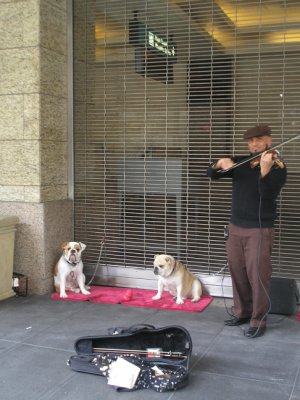
Another aspect regarding Seattle
is that I've experienced it as a city that also tries to incorporate
some aspects of the country. There are farmers markets” held in
the
various seasons to sell urbanites organic vegetables, in addition to
spring festivals and summer concerts held in wide, open space
parks.
Such things seem to be attributes of the country lifestyle and yet in
Seattle such activities are very intentionally included in the urban
experience. Even within the vicinity of 4th & Pine, nature is
not
that far away as evidenced in the waterfront. Granted you have to
walk
a few blocks down past the market, past the park with the totem pole
and sleeping homeless people, till you'll finally see the waterfront
hovering just beyond the decaying Alaskan Way Viaduct (a notable point
of contention amongst various parties within the city as there is
disagreement on whether or not to be a tunnel as to beautify the
view).
Overall, when I think about how
I perceive Seattle as a city I often think of it in this manner-as a
city trying also to emulate some aspects of the country. On one hand I
feel that my perspective of Seattle as an urban experience has been
considerably molded by my previous job as an aide to a King County
Councilmember. For several months I had to field countless phone
calls
from rural residents who were exasperated with urban dwellers'
inability to put aside their blanket support for all environmental
protection policies and consider the situation as being a more complex
problem in which environmental regulations had the potential to
severely restrict landowners' rights to work their own land and earn a
living. Such a division between rural and urban citizens seemed
to
reflect that urban people's approval of certain aspects of rural
lifestyle run somewhat close to the surface.
Perhaps even more influential
has been my experience growing up in Hawaii. Honolulu is comparatively
not that much smaller than Seattle in terms of population, however in
terms of geographic space the city is within easy access of all those
living in surrounding areas. Consequently, my sense of space is
considerably different from those living on the continental US. The
first half of my life I lived in towns that weren't rural in that there
was an absence of an agricultural economy, however I distinctly
remember discovering that the bus that I took to and from school, which
was located in Honolulu, was considered a “country” bus. Such a
categorization seemed perplexing to me since my town was only a 25
minute drive away from the city. In many ways my experiences back
home
in Hawaii, working for King County, and living in Seattle for the past
three years leave me with an ambiguous understanding of what rural and
urban actually means, as it seems to be easily identifiable on street
corners but harder to explain in absolute terms.
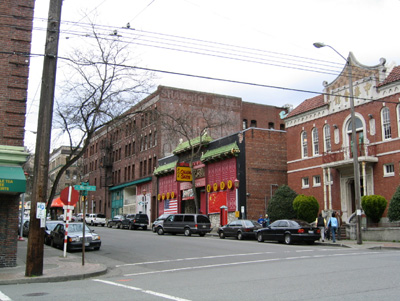
One of my favorite intersections in
Seattle is the intersection of the Seventh Ave and Weller St. in
Chinatown-International District. Chinatown is located several blocks
southeastern from downtown Seattle. As many Chinatowns in other major
U.S. cities, this Chinatown is largely a commercial zone and tourist
site. You find in here restaurants, hotels, speciality stores, and a
museum of Asian immigration history. The name “Chinatown” is misleading
in the sense that this community actually includes not only Chinese,
but also Koreans, Filipinos, Vietnamese, and Laotians. The history of
this Chinatown can be traced back to late 19th century when Chinese
laborers were recruited to the U.S. to work in lumber mills, fishing
boats, railroads and domestic services. These Chinese immigrants built
up a Chinatown in waterfront, but its existence was severely threatened
by political and social persecutions against Chinese immigrants during
1870's and early 1880's. Some Chinese immigrants were forcefully moved
to San Francisco during that period. Then the Great Seattle Fire
completely destroyed the Chinatown in 1889. The Chinese Americans thus
built a second Chinatown on Washington Street and Second and Third
Avenues. However, the rising property value in that area made
economically disadvantaged Chinese immigrants to move and to build a
third Chinatown on Kong St, the Chinatown that stands to the present.
Something odd but true about Chinatown is that, although I am a
Chinese, I hardly feel at home with any Chinatown that I have visited
in the U.S. Each time I stroll around Chinatown, browsing the
stores and restaurants on the both sides of its street, I can not help
feeling how ridiculous this place is called “Chinatown” while nothing
there really resembles China and its towns that I am familiar with. The
speciality stores are rarely held by Chinese; rather, they are mostly
Vietnamese, Japanese, or Taiwanese stores. You can find some goods
imported from China in these stores, but it takes me two years to find
a certain brand of instant noodle that I can easily find in any grocery
store in China. The Chinese restaurants in the Chinatown serve
American-Chinese food, as many other Chinese restaurants in the U.S.
do. They have on their menus “Hunan Niu” (Hunna Beef) and “Sichuan Ji”
(Sichuan Chicken), something that restaurants in China do not serve at
all. And they give the customers “fortunate cookie” when they finish
dinners, which is rarely found in China. Most of the store owners, shop
clerks, restaurant waiters (waitresses) speak either Cantonese or
Southern Fujian Dialect, two languages I don’t know how to speak. I
have to speak English whenever I need to talk to them.
I didn’t like the Chinatown very much also because it looks worn-out,
not well organized, and…dirty, especially when compared to the Quest
Field and downtown Seattle that are just a few blocks away. Some of the
stores have a bad smell and are always overcrowded. For me, going
shopping there is not as comfortable as in the Macy’s or the Nordstrom.
I thought of this place as less modern than other part of the
downtown—it is like the rural area within the urban region.
So why
does this intersection in Chinatown become my favorite? Here is the
story. One day in this February, I went shopping in the Chinatown with
a friend that I got to know from last semester. She is from Canton
province and speaks Cantonese as well as a bit Southern Fujian Dialect.
Something strikes me immediately after we arrived at the Chinatown is
that she seems to like this place a lot. Whereas I just go to one or
two stores, she knows where to buy Cantonese style cakes, where to buy
good tea, and where to have nice dim-sum. She even makes friends with a
shop clerk and a Chinese medicine doctor! Whereas Chinatown is not
“Chinese” enough for me, it is obviously very “Chinese” for her. We
went to the dim sum restaurant (please see the picture), China Gate,
for lunch. She looked like completely at home—telling me what to order
and actually ordering food for me, talking to the waitresses and the
manager as if they were old friends. For a moment, I felt like she and
I were not from the same motherland.
This experience tells me how one’s perception of a place connects to
one’s history. Since I was not grown up in southern China and I am not
familiar with Canton culture, it is hard for me to identify myself with
the Chinatown, of which the earliest immigrants were largely from
southern China, especially Canton area. But my friend, who lives in
Canton area for many years, is easy to find a feeling of belonging in
Chinatown. Also, this experience challenges the singular version of
Chineseness that I had in my mind. What I think is authentically
Chinese might not be what my friend thinks of. Chineseness is
multi-stranded and with multiple versions. The ambiguity of
“Chineseness” expressed by Chinatown should not be considered as its
inability to gain a “real” sense of China, but should be understood
within its own context. If you look at the China Gate restaurant on the
picture, you will find that its architecture—with the shining red wall,
pavilion roof, big wooden windows with traditional design and
carvings—resembles that of many restaurants in China. However, on the
outer wall are two large same-sized national flags. One is American
national flag; the other is the one of China. This is what is so unique
about Chinatown. You can’t find such “decorations” in China. It is not
so important whether or not this is authentic a Chinese thing. What is
important is—What does these two flags coexisting in this Cantonese
restaurant mean to the local residents? What is the history behind the
hybridity of the cultural elements in Chinatown? Are the cultural
elements from China, Koreans, Filipinos, Vietnamese, and Laotians
equally accepted in Chinatown? How do the local residents identify
themselves and their relations with China, Japan, Korea, and other
nations? Do the local residents have a hierarchy in terms of cultural
identity? ……
It is the intersection of Bellevue Avenue East, Bellevue Court East and Bellevue Place East, caused by one of Seattle’s irregular meetings of the street grid. This city is quite famous for its unusual and confusing street patterns.
I chose this intersection because it is near my building and that the convergence of three streets with one name is an interesting, unusual event. It’s almost like something out of a cheesy horror film – that the vortex of the universe is located where three streets come together.

Bellevue Avenue East has many
apartment buildings, all built around 1920, featuring dark brown brick.
Lately, there have been some newer buildings built, an in fact, on the
western side of the street there is a construction site for a new
condominium building. A convenience store and a coffee shop occupy a
site just to the south of these. The rest of the area is full of these
early 20th Century buildings.
Ever
since the pioneers of the
city moved across the bay from New York-Alki (now Alki Beach), the
argumentative founders of the city laid out competing street grids,
causing confusion and disorder. One founder, “Doc” Maynard laid out his
streets according to the North Star, while Arthur Denny and Carson
Boren wanted them to follow the bay. Reports
say that one of the founders was drunk – he was well known for this.
This intersection is located in a
quieter part of the city, first settled in the early 20th century.
Capitol Hill has developed into an area of large Arts & Crafts and
Tudor homes and apartment buildings. This intersection, commonly called
“the vortex” by my friends, is at the border of apartment buildings,
condominiums and the larger dwellings a little bit further up the hill.
It forms a nice divide.
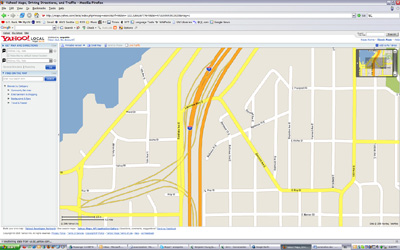
One other thing I
like about this
intersection is that it forms the northern end of one of Seattle’s many
electric trolley routes. This mode of transportation is both
anachronistic and annoying; the technology is only used in a few cities
in North America and has proven especially costly, but it is
environmentally friendly. It is annoying when you are riding on one of
the trolleys (or behind one in traffic) and they constantly come off
the wires causing delays of two minutes to an hour, depending on the
location.
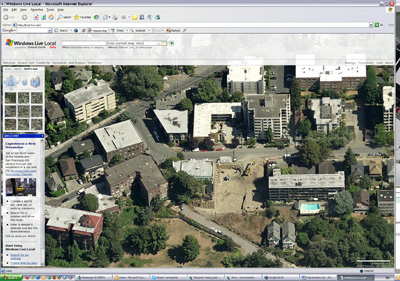
The “vortex” provides a nice boundary
– with the transition in housing styles from dense urban multi-unit
housing to single family homes on narrow tree-lined streets. These are
the two big kinds of housing in Seattle and this separation is fairly
well demarcated here.
So, as an important boundary
between
two types of housing and urban environments on Capitol Hill and having
the unique property of three streets with the same name crossing
themselves, I find that this “vortex” is my favorite intersection in
Seattle.
(Bill)
Just a block north of Volunteer Park, adjacent to the Lakeview Cemetery at the crest of Capitol Hill, bordering Interlaken Park, which is otherwise known to locals as “the ravine”, and forty-odd yards past the end of the number 10 bus route, there is a large iron sculpture and a tree surrounded by a triangular bench. This is the intersection of 15th and Garfield, and it is the heart of my original neighborhood. My birth-house is the second house to the east, right where Garfield cuts sharply downhill. From the tree, there is a sweeping view to the north of Union Bay, Husky Stadium, and the lake and mountains in the distance. A thin path switches down the Hill into the trees and disappears under their canopy, which forms a green shroud that stretches across the slope in the summer months.
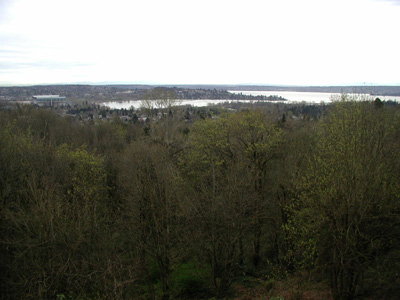
Not too far from the intersection is a knoll in the cemetery where
Bruce Lee and his son are buried. The earth rises gently to one of the
highest points in the cemetery, with a view to the east overlooking the
densely clustered Chinese section of the graveyard, and in the shade of
a big evergreen are two gravestones side by side, father and son. When
I was a little boy my father took me to fly kites in the cemetery near
the gravesite, because as the highest spot on the Hill, it was also the
windiest. I used to fancy that the kite was lifting the spirits of the
dead up from their heavy, wet graves into the light fresh air, and that
it made them free. However, on autumn mornings when the wind set still,
a thick mist would sometimes fall over the Hill and the brown leaves,
heavy with dew, would drop into the mud. At those times I feared the
dead, and the silence and weight of the fog seemed to conceal sinister
forms. On such grim days, my grandfather sometimes took me on early
morning walks past the cemetery and up to what is now the museum of
Asian art in Volunteer Park. As we walked quietly through the grey-blue
early morning mist, I wouldn’t dare leave his side.
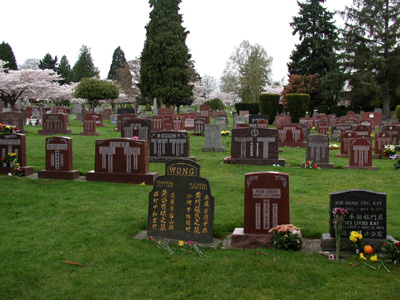
Many years later, I went to the cemetery with my friend Adrienne to show her Bruce Lee’s grave. It was a cold, grey afternoon almost exactly 13 years ago, and we were on a trip of sorts. At the time, Bruce Lee’s old granite tombstone with his scratched-out photo - my father said that it was his enemies who had desecrated his grave - still stood on the spot. We learned the next day that Brandon Lee was shot to death while filming a movie as we stood where he was to be buried, next to his father. I wondered whether those enemies who scratched out Bruce Lee’s photograph had put an end to his son. Later, whenever I tried to talk about it with Adrienne, she would always change the subject. She must have felt it ominous to have stood before a man’s grave as he died, as though she had unwittingly paid homage to the angel of death.
I seldom visit the intersection these days; its effect is too strong. The memories from that place, both pleasant and painful, can be overwhelming. The past is like the fog that sometimes settles over the Hill, and its events are the ghosts that wander through the mist, silently, and just out of sight. Perhaps if I still had my grandfather by my side I could face them without trepidation, but now he, too, is beyond my mortal perception. So now I must go alone, and alone I hear the voices and see the figures of years gone by until suddenly I am a little boy again, responding in vain when the void calls out my name.
Up there on the Hill, that intersection of two mundane streets, with its monolithic sculpture, cemetery and house of my birth, represents an intersection of the past and present; the living and the dead. It is the nursery of my memories, which were conceived in the passing of people and events.
(Jaya)
Is
the rural-urban relation termed in anthro-centric terms if we talk
about the intersection which observes trade of food commodity, such as
the one at 12th and 50th in the U District where farmers gather between
the months of May and December to market natural and organic foods from
Washington farms both west and east of the Cascade Mountains?
Though empty in the first four months of the year, this parking lot
witnesses many transactions that stand outside standard US markets
where most Americans shop for food, like Safeway, Thriftway, and IGA,
but still they are relegated to hours of business, only once per week,
for five hours. Not competitive with the 24 hour service, how do
sales compare between the Farmer’s Market and the Safeway across the
street?
Here,
I would like to depart from human markets and think about a 24 hour
cycle of sleeping and eating that goes on outside of standard business
account and yet within Seattle City limits. I am reflecting in
the style that I was trained to do in high school biology class when
carrying out the assignment to spend ‘Thirty Minutes Alone with Mother
Nature.’ Where water has edges, there is a different kind of life
in Seattle, wildlife and citizens relaxing for an afternoon on trails
and decks that have been built with public funds. The Montlake
Bridge itself is flexible; it is made of steel grid deck and has two
stone watch towers, one on each end. If a yacht or barge passing
through the canal is too tall, the pilot signals and the bells begin to
ring. An attendant in the watch towers sees that the red and
white safety bars go up while the deck ascends vertically into the air,
meanwhile Montlake Boulevard traffic, both pedestrian and vehicular,
stalls, waiting for the boat to pass. Idling their motors while
waiting, or stalling at the 520 freeway entrance during congestion, or
while hunting for parking places during a Husky game, how many tons of
extra fossil fuels are consumed at this narrow intersection of nature’s
modified waterways and the other mode of transport in the 20th century
modernized environment, the constructed concrete pavement?
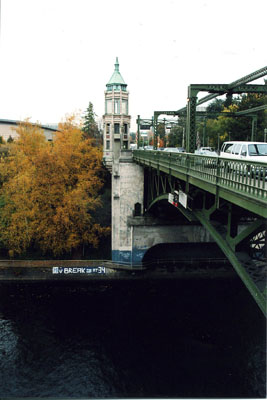
What
kind of traffic have I seen passing here? I have already
mentioned the yachts of various sizes that sally up from the yacht
club, and there are barges loaded with soil and gravel for construction
projects far across the lakeshore. Also, teams of UW rowers ply
the water in synchronized strokes, according to the commands of
attending coach boats. Occasionally a single person, in a kayak
passes through quietly, most likely to encounter the life that I will
now account. On the Lake Union end of the canal, there are tall
cottonwood and alder trees. At night the flocks of crows gather
from around the neighborhood, taking residence in the tops of the
branches every night. Does this crow rookery represent a rural
environment within Seattle City limits? Not exactly, not just any
bird, the crow is a city dweller. But, on the other bank, the
cormorants take roost. Farther down the water lane, out where the
view is broad, across the lake, the Bald Eagle stakes winter claim to
hunting grounds. Lake Washington is a great place to catch ducks,
wild ducks that come here to rest in winter, waiting for summer thaws
in arctic marshes. The ducks, the crows and the eagles are sleep
and eat, here in Seattle city limits. Not only in rural
environment, but in urban environment, humans are not creating a
separate world from the natural ecological cycles of our external
environment, even if we could magically produce all of the food we
needed under plastic bubbles, in automated systems, requiring no
immigrant labor from the villages of Mexico, on top of our roofs, we
are still sharing that waterway, that road way with more than
crows. Humans are part of the ecology on this planet.
At the
intersection of Montlake and Lake Washington-Lake Union, I learned that
though I live in the city, I am able to walk out my door and see
otters, the same as when I lived in rural isolation in the Oregon Coast
mountain ranges. If I can get past the sound of traffic,
imagining the roar to be a background of ocean rumble, and to ignore
the scent of exhaust that clings to the moist air, I can adjust to my
rural-urban transition. Two seasons have already passed, and I am
reassured. But, I am unsure about the fate of the homeless men
who often stand at one end or the other of Montlake Bridge, blankly
staring, speaking into space, how did they adjust? Will I too,
one day be the crazy one that loses footing in the city, relegated to
church food bank handouts and sleeping under shrubs? Being
female, do I have more claims to commodity distribution than males in
homelessness? While crows get fat from dumpster diving and sleep in
socialized rookeries at night, without my mother, would my father who
now has Parkinson’s and has lost cognitive powers before retirement
have to sleep under bushes?
Last
Updated:
05/01/06
Contact the instructor at:
swelland@u.washington.edu